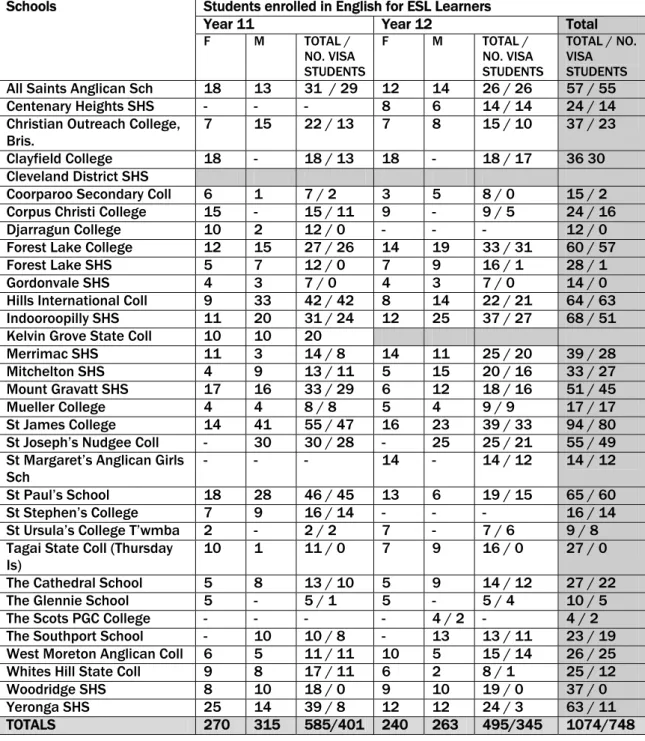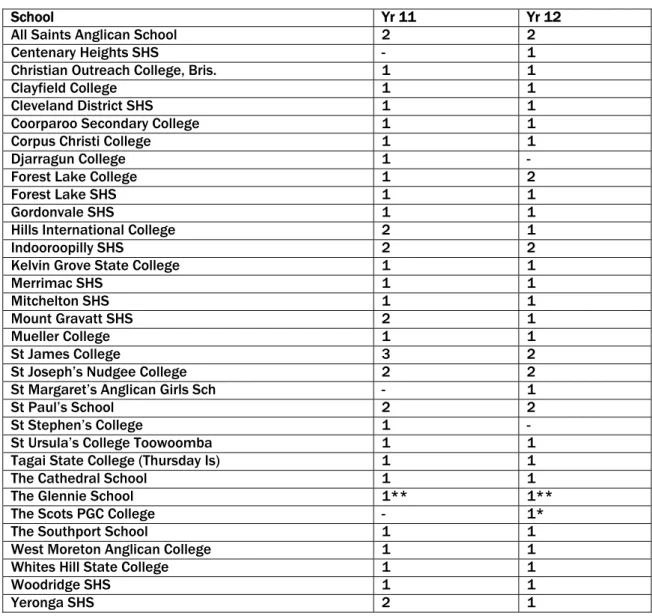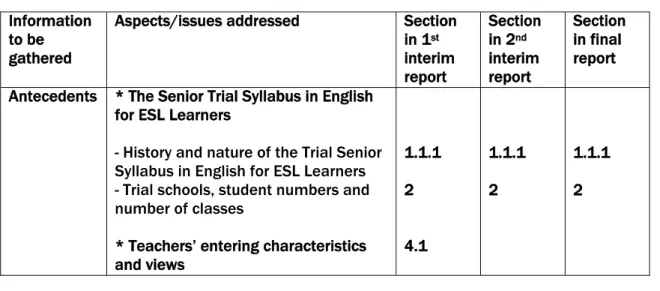The following points (meeting minutes) outline the development of the syllabus since that March 2006 meeting. Australian English is not the first language of the local community (current English for Seniors Syllabus Appendix). At the English for ESL Learners teacher conference in March 2009, teachers were shown a modified version of the syllabus.
The assessor's second interim report (July 2009) and final report (February 2010) will guide further revision of the syllabus; And. This report is the final report of the evaluation of the Senior Syllabus English for ESL Learners Trial, which covers the period February 2008 – December 2009.
RECOMMENDATIONS
If it is mandatory for schools to include indigenous perspectives in their course of study (as opposed to these perspectives being optional), this requirement should be clearly stated in the curriculum, with indigenous perspectives reflected in schools' programs of work. This, in the revision of the English language curriculum for ESL learners (March 2009), follows. That, in order to enhance the relevance of the subject to students, the Queensland Studies Authority continues to liaise with the Queensland Tertiary Admissions Center (QTAC) regarding the acceptance of the subject, English for ESL Learners, for tertiary entry purposes by all Australians Universities and that QSA continues to advise schools on progress in this direction.
The suitability of the criteria in the eligibility statement to determine the students to whom the syllabus is intended to address. That consideration be given to developing an ESL program specifically designed to support teachers of English for ESL students, and that probationary teachers with expertise in ESL teaching/learning principles be invited to assist in this endeavor.
TRIAL SCHOOLS
TRIAL SCHOOLS AND STUDENT ENROLMENTS
Enrollments from the three schools with mainly indigenous students taking the subject (Djarragun College, Gordonvale SHS and Tagai College) accounted for about 5% of the total enrolment. The number of enrolled students at the trial schools varied from four to 94 students at the school with the highest enrollments. There were 14 public schools in the trial and 18 non-government schools, including the school that participated in the trial for the first time in 2009;.
Within the non-government schools there was a mix of Catholic and independent schools - some were all girls' schools, some were all boys' schools, while the rest were co-educational schools. There were three schools that took part in the trial in 2008 and did not offer the subject to Year 11 students in 2009, namely Centenary Heights SHS, St Margaret's Anglican Girls School and The Scots PGC College.
NUMBER OF CLASSES AT EACH TRIAL SCHOOL, 2009
METHODOLOGY
CONCEPTUAL MODEL/FRAMEWORK – AN OVERVIEW
Tertiary qualifications completed - Teachers' views on the level of clarity of the curriculum in communicating its intentions - Types of teaching assistants. Other subjects studied - Reasons for taking English for ESL students, including the most important reason. Framework for Employability - Report Commissioned by QSA - Developing a Set of Principles to Guide a P-12 Curriculum Framework, January 2008.
RESEARCH STRATEGIES
The focus of the teachers' conference in March 2009 was on feedback from monitoring and preparation for the October verification. Appendix B to this report represents notes of teachers' comments from a workshop run by the evaluator at this conference. A summary of responses to the first teacher survey was included as Appendix B in the first interim report.
Summaries of the teacher survey responses administered at the October 2008 and March 2009 teacher conferences are included in the second interim report – Appendices B, C, and J, and the responses to the October 2009 teacher survey are included in this report – Appendix A. Additional 22 visits to schools were carried out by the evaluator in the period July 2008 – end of June 2009, including a visit to a new school in the trial in 2009. Summaries of Year 11 pupils' responses to a survey administered in May 2008 were included in the first interim report – Annex D.
The evaluator contacted all sample schools in June 2008 and asked them if they had problems with the curriculum. The feedback from this project manager, who supported the teachers at Gordonvale SHS and Tagai State College with the implementation of the curriculum throughout the trial, was shown in the first interim report in Appendix F. The evaluator also had the opportunity to speak with this person, who is now the ESL Project Officer with DET (but still supporting the North Queensland schools) in May 2009.
THE ‘SETTING’ OF ENGLISH FOR ESL LEARNERS – THE
ANTECEDENTS’ PHASE
INTRODUCTION
THE BROADER ENVIRONMENT – ISSUES OF RELEVANCE
The Validation Unit will look after student results and an email will be sent to all trial schools over the next two weeks outlining the process that Year 12 English for ESL students must follow from now on. The advice will include the contact name and details of a person/organisation that the student or school can contact when the results are officially announced, until universities start in 2010. The QSA will honor its commitment to those students who have taken the course, and will do everything in their power to ensure a smooth transition from school to university for those students who follow this particular path.
A second course will be developed for students from diverse backgrounds with English as an Additional Language or Dialect (EAL/D), including Indigenous students. This course will offer a variety of language, literature, and literacy experiences, as well as several pathway options to accommodate the range of student ability. At the October 2009 teacher conference, the Assistant Director, Senior Curriculum Resources Branch, QSA, provided an update on the national curriculum and its impact on the Trial Senior Syllabus in English for ESL Learners syllabus.
English as an additional language or dialect is being developed nationally and will replace QSA's Trial Senior Syllabus in English for ESL Learners syllabus. To reduce the impact on schools, the QSA will extend the trial of English for ESL students beyond 2010. There will be no pilot phase; However, the recommendations from the evaluator's report will still prompt refinements to be made to the syllabus that will last schools until the end of 2011.
The Assistant Principal indicated that using the high-level English Test for ESL Learner curriculum will prepare teachers well to implement the Australian Curriculum Assessment and Reporting Authority (ACARA) curriculum. States/Territories will continue to implement their own assessment systems and Queensland will continue with school-based assessment – ACARA will provide the content and standards. ACARA appears to be ambivalent about whether or not English as an additional language or dialect will meet the aims of tertiary entry and the QSA's advice to ACARA has been that this needs to be clarified.
IMPLEMENTATION IN SCHOOLS
- THE RELEVANCE OF THE SUBJECT TO STUDENTS .1 Students’ views - implementation in schools
- THE APPROPRIATENESS OF THE ASSESSMENT REQUIREMENTS OF THE SYLLABUS This issue was further explored by the evaluator with trial school teachers at the October
Some teachers from other schools indicated during the evaluator's school visits and at the teachers' conference in October 2009 that their school could also consider this option. The reviewer therefore feels it is important to recommend that the revision of the Trial Senior Syllabus in English (2008) take into account the fact that an increasing number of ESL students are likely to take this course. Students interviewed by the evaluator during school visits in the 4th semester of 2009 agreed that the name of the course should be changed.
They preferred the name recommended by the assessor in the second interim report, English as an Additional Language or Dialect, as it would give up the ESL label. Students at one school said that "most of us think we're stupid", even though the subject is at the same level as the authority English. Students at another school said that at their school, "people here think ESL is easier or dumber."
The following table, Table 4, shows overall achievement levels for Year 12 students who left English for ESL Learners at the end of 2009. The gender distribution of achievement levels for English (2002) represents a relatively similar picture to that for English for ESL learners with exit levels of achievement for women for English (2002) higher in the VHA, HA and SA levels, and lower than men in the LA and VL levels. A greater % of English leavers (2002) achieved a VHA or HA level than students of English for ESL learners;.
A greater proportion of students exiting English for ESL learners achieved an SA level than English students (2002); and. A greater percentage of ESL learners achieved a LA achievement level than English learners (2002). It shows that 43% of teachers did not find it easy to determine the achievement levels of students.

Have you found it easy to determine students’
- RESOURCES FOUND TO BE USEFUL IN TRIAL SCHOOLS
- THE DEVELOPMENT OF APPROPRIATE STANDARDS FOR STUDENT ACHIEVEMENT Fourteen per cent of the respondents to the evaluator’s October 2009 teacher survey felt
- RECOMMENDATIONS
- NAME OF TEACHER*
- THE ENGLISH FOR ESL LEARNERS SYLLABUS (AMENDED MARCH 2009) – SECTION 6, ASSESSMENT
- PLANS FOR 2010
- RESOURCES
- SUGGESTIONS FOR IMPROVEMENT
It is recommended that these comments, as well as those included in the second interim report, be taken into account when revising this section of the syllabus. Each teacher has a strong opinion/perception of the course which makes cross marking time consuming. Please comment on the following aspects of Section 6, Assessment, of the English for ESL Learners Revised Syllabus (March 2009).
Circle the answer that most closely matches your opinion of the appropriateness of this section of the syllabus. Text – Half of the Yellow Sun (Adiche); Night (Elie Wiesel); My Place (Sally Morgan); various biographies. Griffith University will accept a number of students at the end of year 11 and offer a bridging programme.
Unfortunately, we get 3rd and 4th international students and only one passes in year 11. The Coordinator of the International School informed the evaluator that only 11% of English for ESL learners students pass the subject.). Four of the students said the subject was about the same level of difficulty as their other subjects; two felt it was more difficult, especially 'when we do Shakespeare'. Two of the students said there was a lot more work in this subject than they thought there would be and five said they thought it would be easier than it is.
Most students said this subject is their easiest subject and about half said there was less workload in English for ESL students than in their other subjects.



